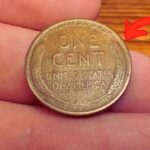When most people think of a penny, they typically imagine a small, nearly worthless coin that’s barely worth picking up off the sidewalk. For the majority of modern U.S. pennies, that perception holds true. However, some pennies are far from ordinary. Among the vast sea of copper and zinc cents, a handful of unique and historically significant coins have captured the attention of numismatists and collectors alike. One of the most legendary among them is the Lincoln Wheat Penny, a humble-looking coin that could potentially fetch up to $880,000 at auction.
Sound unbelievable? It’s not. Certain versions of the Lincoln Wheat Penny are now considered extremely rare and valuable due to unusual minting errors, short production runs, or composition anomalies. And what’s even more fascinating is the possibility that one of these valuable pennies could still be circulating in everyday change.
The Lincoln Wheat Penny Valued At $880k, Still in Circulation?
The Historical Background of the Lincoln Wheat Penny
The Lincoln Wheat Penny made its debut in 1909 to commemorate the 100th anniversary of President Abraham Lincoln’s birth. It was the first American coin to feature a real historical figure rather than an allegorical representation like Lady Liberty. Designed by sculptor Victor David Brenner, the front of the coin proudly displays a profile of Abraham Lincoln, while the reverse side is adorned with two stylized wheat stalks curving inward toward the phrase “ONE CENT” and “UNITED STATES OF AMERICA.”
Produced from 1909 to 1958, the Lincoln Wheat Penny remains one of the most iconic coins in U.S. history. After 1958, the reverse design was replaced by the Lincoln Memorial, marking the end of an era for this classic design. Still, collectors remain fascinated by Wheat Pennies, especially those minted under unique or unusual circumstances.
Why the 1943 Lincoln Wheat Penny is Worth $880,000
While all Lincoln Wheat Pennies have historical appeal, one particular version stands out as the crown jewel of the collection—the 1943 copper Lincoln Wheat Penny. During World War II, the U.S. Mint faced a copper shortage, as the metal was prioritized for wartime production. As a result, the Mint decided to produce pennies using zinc-coated steel for the year 1943. These steel cents had a distinctive silver-gray appearance and were noticeably lighter than their copper predecessors.
However, in the midst of this transition, a few copper planchets (blanks) from the previous year inadvertently found their way into the minting machines. The result? A handful of 1943 Lincoln Wheat Pennies made of copper, rather than steel.
Estimates suggest that fewer than 20 of these 1943 copper Wheat Pennies exist today, making them exceptionally rare. Because of their scarcity and historical significance, these pennies can command staggering prices at auction. In fact, pristine examples have sold for upwards of $880,000, making them among the most valuable coins ever released into general circulation.
Quick Reference Table: Lincoln Wheat Penny Highlights
| Feature | Detail |
|---|---|
| Coin Name | Lincoln Wheat Penny |
| Year Introduced | 1909 |
| Valuable Variant | 1943 Copper Error |
| Common Material (1943) | Zinc-Coated Steel |
| Rare Material (1943) | Copper |
| Estimated Top Value | Up to $880,000 |
| Notable Reverse Design | Two Wheat Stalks |
| Circulation Years | 1909 to 1958 |
How to Identify a Rare Lincoln Wheat Penny
If you’re interested in checking your coin jar for hidden treasures, knowing how to spot a valuable Lincoln Wheat Penny is essential. Here are a few key identifiers to help you determine whether you have a run-of-the-mill penny or a once-in-a-lifetime find:
1. Check the Date
Start by examining the year. A 1943 Lincoln Wheat Penny is your starting point, but remember—most of these are made of steel. You’re looking for a copper-colored version with a 1943 date.
2. Use the Magnet Test
Place a magnet next to your 1943 penny. If the coin is attracted to the magnet, it’s steel. If it doesn’t stick, you might have a copper version. This simple test can instantly help eliminate common coins.
3. Weigh the Coin
An authentic copper Wheat Penny typically weighs about 3.11 grams, while a steel version weighs around 2.7 grams. A basic coin scale can help determine the material.
4. Inspect the Color
Copper Wheat Pennies have a reddish-brown hue, while steel versions appear silvery-gray. However, some steel coins have been copper-plated by scammers, so color alone isn’t definitive.
5. Check for Mint Marks
Mint marks like “D” (Denver) or “S” (San Francisco) can also affect a coin’s rarity and value. However, the most valuable 1943 copper Lincoln Wheat Pennies typically don’t have a mint mark.
6. Consult an Expert
If your coin passes the preliminary checks, don’t attempt to clean or alter it. Instead, consult a certified coin grading service like PCGS (Professional Coin Grading Service) or NGC (Numismatic Guaranty Corporation) for authentication.
Other Rare Lincoln Wheat Pennies to Watch For
While the 1943 copper error is the most famous, several other Lincoln Wheat Pennies are also highly sought after:
- 1909-S VDB: The first year of the Lincoln cent had limited mintage in San Francisco, and the designer’s initials (V.D.B.) appeared on the back. These coins can sell for thousands.
- 1914-D: A low-mintage year from the Denver Mint, these coins are worth serious money in good condition.
- 1922 No D: Some 1922 pennies were minted in Denver but have no mint mark due to die wear, making them valuable.
Why People Still Find Lincoln Wheat Pennies in Circulation
Even though the Lincoln Wheat Penny hasn’t been minted since 1958, it’s not uncommon for people to find them mixed in with modern coins. Many older pennies remain in circulation or are hidden away in coin jars, family piggy banks, or inherited collections. That means your next rare find could be closer than you think.
Every so often, stories emerge of someone discovering a valuable Lincoln Wheat Penny while sorting change or cleaning out a relative’s attic. These moments remind us that history and wealth can lie in the most unexpected places.
Where to Sell a Valuable Lincoln Wheat Penny
If you believe you have a rare coin, resist the urge to sell it on impulse. Follow these steps to ensure you receive its true value:
- Authenticate the Coin: Use reputable grading services like PCGS or NGC.
- Appraise Its Value: Consult a coin dealer or online numismatic community.
- Sell Through Reputable Channels: Consider major auction houses or certified coin marketplaces to reach serious buyers.
Selling a coin worth thousands or hundreds of thousands of dollars requires careful planning and professional guidance. Avoid casual buyers or unverified online listings.
Final Thoughts: The Power of a Penny
It’s astonishing to think that a small one-cent coin could be valued at nearly a million dollars. The Lincoln Wheat Penny exemplifies how history, rarity, and a bit of luck can turn an ordinary item into a priceless treasure. Whether you’re an avid collector or someone who just enjoys rummaging through old jars of coins, the potential reward makes it worth the effort.
So next time you receive change at the store or go through an old coin collection, pay close attention. You never know—that unassuming penny might just be your ticket to a life-changing discovery.
Some Important Link
| Download News APP | Click Here |
| WhatsApp Group | Click Here |
| Home Page | Click Here |










